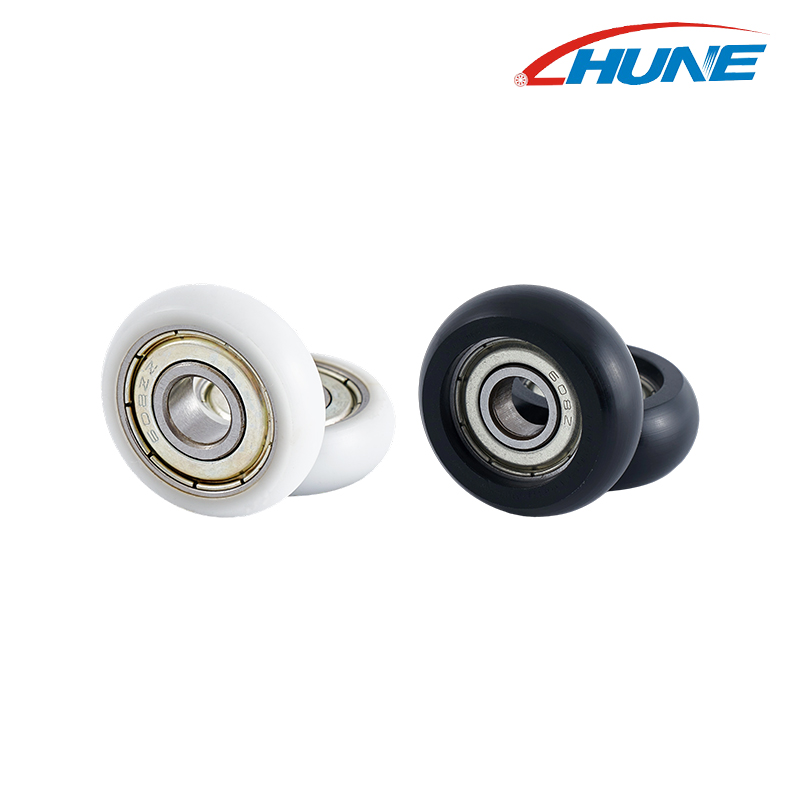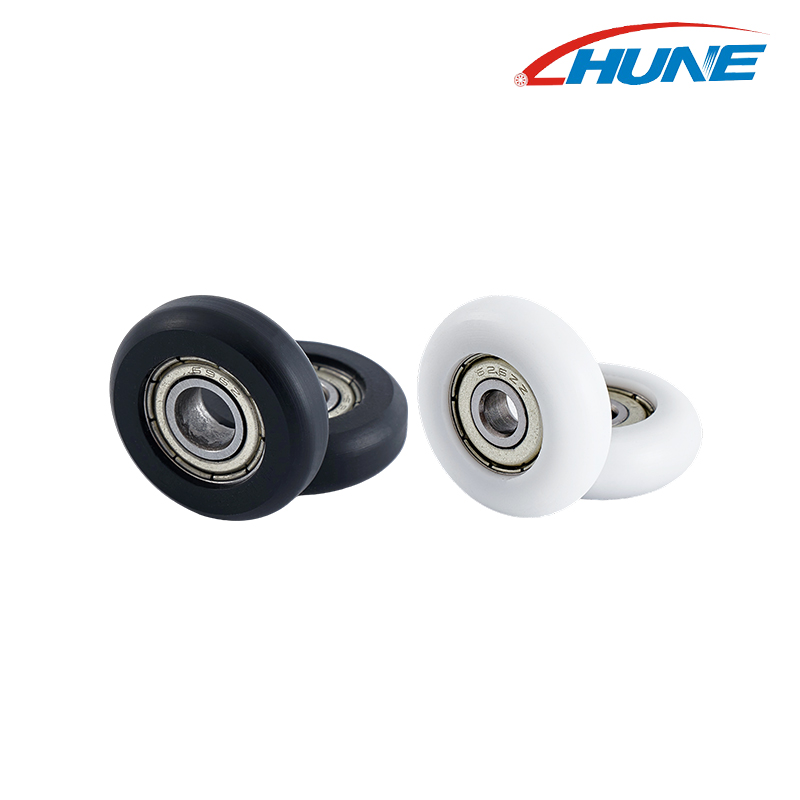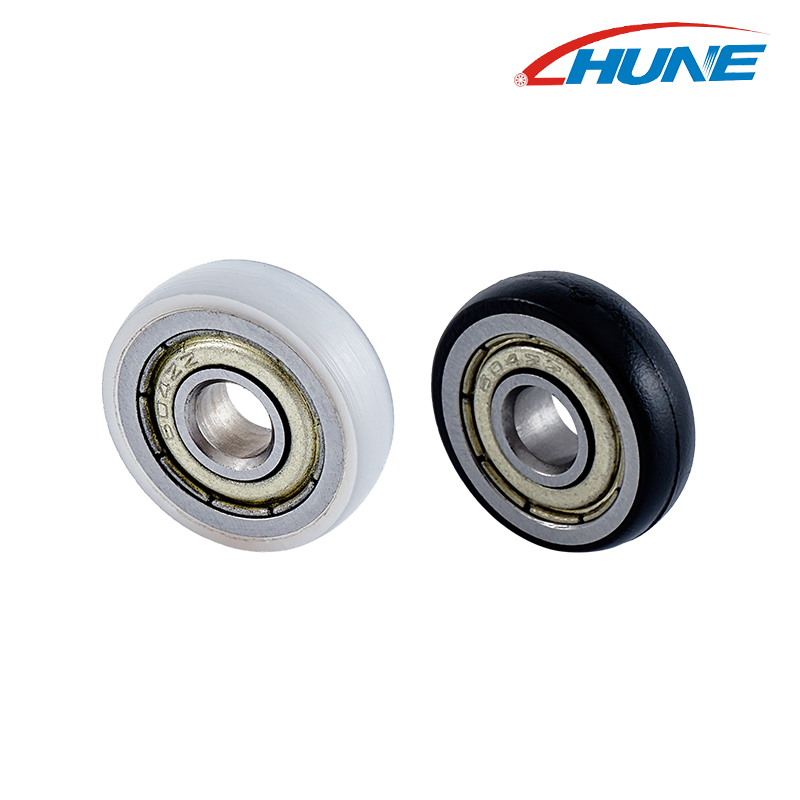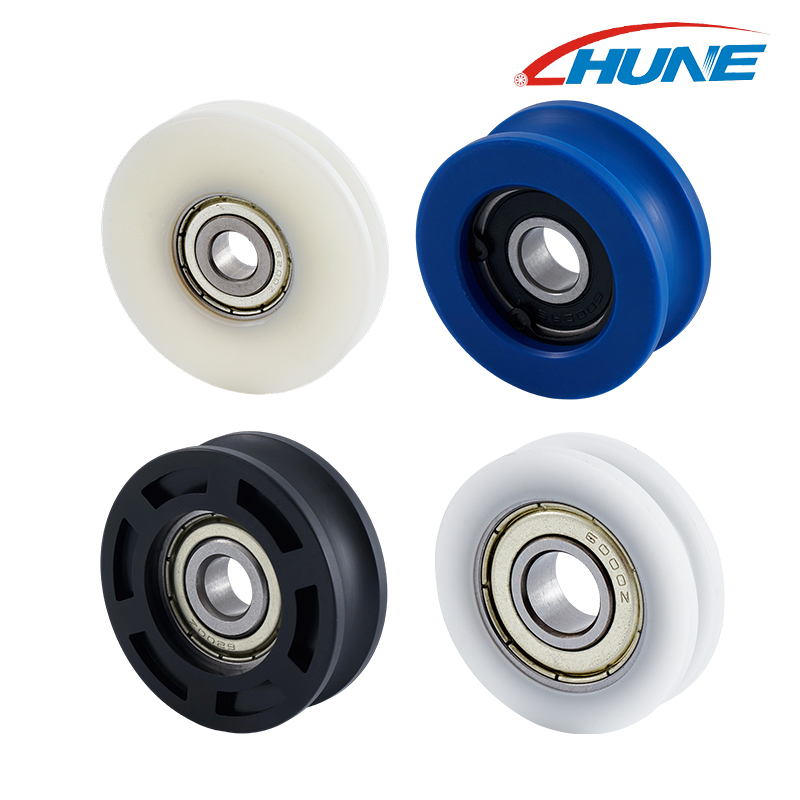A Ball Bearing Pulley Wheel is a mechanical device designed to guide or support the movement of a cable, belt, or rope while reducing friction through the use of ball bearings. Unlike plain pulleys that rely solely on surface contact, ball bearing pulleys feature tiny rolling bearings inside the wheel hub — allowing for smoother, quieter, and more efficient rotation.
These pulley wheels are widely used in industrial machinery, gym equipment, marine rigs, and conveyor systems where durability, speed, and consistent performance are crucial. By minimizing friction, they help reduce energy loss and extend the lifespan of both the pulley and the system it drives.
Key Components of a Ball Bearing Pulley Wheel
A well-designed ball bearing pulley wheel consists of four main components, each contributing to its performance and longevity:
Outer Wheel (Sheave)
- The outer ring — also called the sheave — is the surface where the belt, rope, or cable runs. It's engineered with a smooth or grooved design to ensure proper grip and alignment during operation.
Ball Bearings
- These are the heart of the pulley wheel. The bearings allow the wheel to spin freely around the axle, significantly reducing friction and heat. High-precision bearings also improve rotational balance and efficiency.
Axle (or Shaft)
- The axle is the central rod that supports the pulley and provides a stable pivot point for rotation. It must be strong enough to handle dynamic loads while maintaining alignment.
Housing or Hub
- The housing encloses and supports the bearing assembly, protecting it from dust, debris, and impact. In sealed designs, it helps keep lubrication inside and contaminants out — extending service life.
Together, these components create a robust and low-friction system capable of operating smoothly under heavy loads or high-speed conditions.
What Materials Are Ball Bearing Pulley Wheels Made From?
The choice of material directly affects a pulley's durability, weight, and performance. Manufacturers select materials based on the intended application and environment:
- Stainless Steel:
- Offers exceptional strength, corrosion resistance, and longevity — ideal for marine, outdoor, and industrial use.
- Aluminum:
- Lightweight yet sturdy, aluminum pulleys are common in fitness equipment and light mechanical systems where efficiency and speed matter.
- Nylon or Engineering Plastics:
- Perfect for low-load or low-noise environments. They're lightweight, cost-effective, and resistant to rust or moisture.
- Zinc or Coated Steel:
- Used when affordability and moderate durability are priorities — common in general-purpose pulley systems.
In high-performance applications, these materials are often combined — for example, a steel bearing core inside a nylon or aluminum sheave — to achieve the perfect balance of strength, speed, and wear resistance.
What Makes a Ball Bearing Pulley Wheel Special?
At first glance, a ball bearing pulley wheel looks just like any other pulley — a round wheel with a groove that guides a rope, belt, or cable.
But inside, there's a secret: tiny precision ball bearings that completely transform how it performs.
These bearings sit between the inner axle (the fixed part) and the outer wheel (the rotating part). Instead of the surfaces rubbing against each other, the bearings roll smoothly, drastically reducing friction and energy loss.
The result?
- Effortless motion even under heavy loads
- Reduced heat buildup
- Longer lifespan for both pulley and belt systems
It's the same principle that makes bicycles glide easily or car wheels spin smoothly — just on a smaller, more specialized scale.
A Simple Mechanical Explanation: How Ball Bearing Pulley Wheels Work
- Load Transfer:
- When a belt or rope moves over the pulley, it applies force to the wheel’s outer rim.
- Bearing Rotation:
- Inside the pulley, a ring of tiny steel balls rolls between two races (inner and outer rings). These balls carry the load while rotating freely — turning sliding friction into rolling friction, which is far smaller.
- Friction Reduction:
- Because the balls roll instead of slide, the pulley's rotation is smoother and requires less energy input to keep moving.
- Energy Efficiency:
- Less friction means less wasted energy as heat — making the system more efficient overall. This also prevents premature wear on both the pulley and connected components.
Key Benefits of Ball Bearing Pulley Wheels
When it comes to improving performance and reliability in mechanical systems, ball bearing pulley wheels stand out as a smart upgrade. Their precision-engineered design allows for smoother rotation, reduced wear, and higher efficiency — making them indispensable in both light-duty and industrial applications.
|
Feature |
Description |
|
Smooth Operation |
Low friction ensures quiet, effortless rotation. |
|
Energy Efficient |
Less heat and energy loss improve performance. |
|
High Load Capacity |
Even load distribution prevents wear. |
|
Long Lifespan |
Reduced stress extends service life. |
|
High-Speed Ready |
Stable, precise rotation at any speed. |
|
Low Noise |
Quiet motion ideal for fitness and robotics. |
|
Easy Maintenance |
Sealed bearings need little upkeep. |
|
Safe & Reliable |
Consistent tension enhances stability. |
1. Ultra-Smooth Operation
- The ball bearings inside the pulley drastically reduce friction between moving parts. This allows the wheel to rotate effortlessly, resulting in quiet, vibration-free motion — especially useful in systems requiring continuous or high-speed operation.
2. Enhanced Energy Efficiency
- Because rolling friction is far lower than sliding friction, less energy is lost as heat. This means motors and belts work more efficiently, saving energy and improving overall performance in automated or motor-driven systems.
3. High Load Capacity
- Ball bearing pulley wheels are designed to handle heavier loads without deformation or performance loss. The bearings distribute the force evenly across the wheel, reducing localized stress and preventing premature wear.
4. Extended Lifespan
- With less friction and stress, both the pulley wheel and the connected belt or cable last longer. This leads to fewer replacements, reduced downtime, and lower maintenance costs — a major advantage for industrial users.
5. Reliable High-Speed Performance
- In high-speed applications, plain pulleys often overheat or wear out quickly. Ball bearing pulleys, on the other hand, maintain stable and smooth rotation even at high RPMs, ensuring consistent performance without sacrificing precision.
6. Lower Noise and Vibration
- The rolling motion of ball bearings significantly cuts down on mechanical noise. This makes them ideal for fitness machines, elevators, and robotics, where smooth, silent operation is critical for user comfort and accuracy.
7. Reduced Maintenance Requirements
- Sealed or shielded bearing designs require minimal lubrication and care while still offering top-tier durability. Over time, this translates to lower upkeep costs and better operational efficiency.
8. Improved Safety and Stability
- By minimizing slippage and ensuring consistent belt tension, ball bearing pulley wheels enhance system safety and reliability — especially in load-bearing and motion-control systems.
Common Applications of Ball Bearing Pulley Wheels
Thanks to their combination of strength, smoothness, and versatility, ball bearing pulley wheels are used across a wide range of industries and equipment types.
1. Industrial Machinery
- Ball bearing pulleys play a crucial role in manufacturing and assembly systems, keeping conveyor belts, rollers, and automated lines moving efficiently. Their durability makes them perfect for 24/7 heavy-duty operations.
2. Fitness and Gym Equipment
- If you've ever used a cable machine or functional trainer, you've felt the smooth motion provided by ball bearing pulleys. They ensure quiet, fluid resistance, making workouts safer and more enjoyable.
3. Elevators and Lifting Systems
- In vertical lift systems, ball bearing pulleys help distribute cable tension evenly, ensuring safe and stable operation while reducing wear on cables and motors.
4. Marine and Rigging Equipment
- Corrosion-resistant stainless steel or coated ball bearing pulleys are used on boats, cranes, and rigging setups. They handle heavy loads and harsh environments with ease, offering long-lasting performance even in saltwater conditions.
5. Conveyor and Material Handling Systems
- Factories, warehouses, and logistics centers rely on these pulleys to move goods smoothly along conveyor belts — ensuring precise, energy-efficient transport with minimal maintenance downtime.
6. Robotics and Automation
- In robotic arms and automated systems, precision motion is key. Ball bearing pulleys enable accurate, low-friction movement, improving both speed and positioning accuracy.
7. Theatrical and Stage Rigging
- In stage design and lighting systems, these pulleys provide quiet and dependable cable motion, ensuring safe lifting and smooth transitions during live performances.
8. DIY and Engineering Projects
- Ball bearing pulleys are also popular among makers and mechanical hobbyists for building prototypes, model systems, and experimental machinery requiring smooth and efficient motion.
|
Application |
Description |
|
Industrial Machinery |
Keeps conveyors, rollers, and automated lines running efficiently. |
|
Fitness Equipment |
Ensures smooth, quiet motion for cable machines and trainers. |
|
Elevators & Lifts |
Maintains even cable tension and stable operation. |
|
Marine & Rigging |
Corrosion-resistant pulleys handle heavy loads in harsh environments. |
|
Conveyor Systems |
Enables precise, energy-efficient transport with minimal downtime. |
|
Robotics & Automation |
Supports accurate, low-friction motion for robotic arms and automated systems. |
|
Stage & Theater |
Provides reliable, quiet cable movement for lifts and lighting. |
|
DIY & Engineering Projects |
Perfect for prototypes and experimental machinery requiring smooth motion. |
Maintenance and Care Tips for Ball Bearing Pulley Wheels
Even though ball bearing pulley wheels are designed for durability and efficiency, regular maintenance is key to ensuring they keep performing smoothly for years. Neglecting care can lead to increased friction, premature wear, and costly downtime — especially in high-load or continuous-use environments.
1. Regular Inspection
- Perform periodic visual checks to identify any signs of wear, corrosion, or misalignment.
- Look for unusual noises, vibration, or resistance during rotation — these can indicate damaged bearings or dirt buildup inside the housing. Early detection helps prevent system failure and extends equipment lifespan.
2. Keep Bearings Lubricated
- Proper lubrication is the lifeblood of any bearing system. Use high-quality grease or oil recommended for your pulley’s material and operating conditions.
- For sealed bearings, lubrication is built-in and lasts longer.
- For open bearings, reapply lubricant every few months or as specified by the manufacturer.
- Maintaining a clean, lubricated surface minimizes metal contact, reduces heat, and ensures frictionless motion.
3. Clean and Protect the Surface
- Dirt, dust, and debris can build up over time — especially in industrial or outdoor setups.
- Wipe down pulley surfaces with a clean cloth and mild solvent, ensuring that no residue interferes with rotation.
- If your pulley operates in a marine or humid environment, use a corrosion-resistant coating or choose stainless steel components.
4. Check for Proper Tension and Alignment
- Incorrect belt or rope tension can overload the bearings, while misalignment can cause uneven wear.
- Regularly inspect your system's tension and alignment to maintain smooth, balanced operation and prevent premature failure.
5. Replace Worn Components Promptly
- Even the best pulley wheels have a lifespan. If you notice cracks, deformation, or excessive noise, it's time to replace the bearing or pulley.
- Using worn parts can damage connected systems and lead to unexpected downtime — always swap components before they fail.
Can I Customize the Design of a Ball Bearing Pulley Wheel?
Absolutely! Many manufacturers offer custom-designed pulley wheels to match specific performance needs.
Customization options may include:
- Material selection: stainless steel, aluminum, nylon, or composite plastics
- Bearing type: sealed, open, or ceramic bearings depending on load and environment
- Size and groove shape: tailored to fit your belt, cable, or rope dimensions
- Mounting style: single, double, or swivel-mounted pulleys
Custom pulleys are ideal for industries that require specialized load handling, speed performance, or environmental resistance — such as robotics, fitness equipment, and marine systems.
When considering custom designs, always partner with a trusted manufacturer that prioritizes engineering accuracy and material quality.
Encouraging Proper Selection and Maintenance for Optimal Performance
Selecting the right pulley wheel is just as important as maintaining it. Choosing the right material, bearing type, and design ensures your system runs efficiently, quietly, and safely.
To achieve optial results:
- Match the pulley to your load and speed requirements
- Select materials based on your environment (e.g., stainless steel for marine, aluminum for fitness machines)
- Perform routine maintenance and lubrication checks
- Work with reputable brands known for precision manufacturing
If you're looking for reliable, high-quality solutions, Hune is a strong recommendation. With advanced production technology, precision-engineered bearings, and a focus on long-term performance, Hune ball bearing pulley wheels offer the perfect balance of strength, efficiency, and durability for both industrial and commercial applications.
Choose wisely, maintain consistently, and your pulleys will reward you with years of flawless operation.






 English
English  Español
Español  日本語
日本語 









